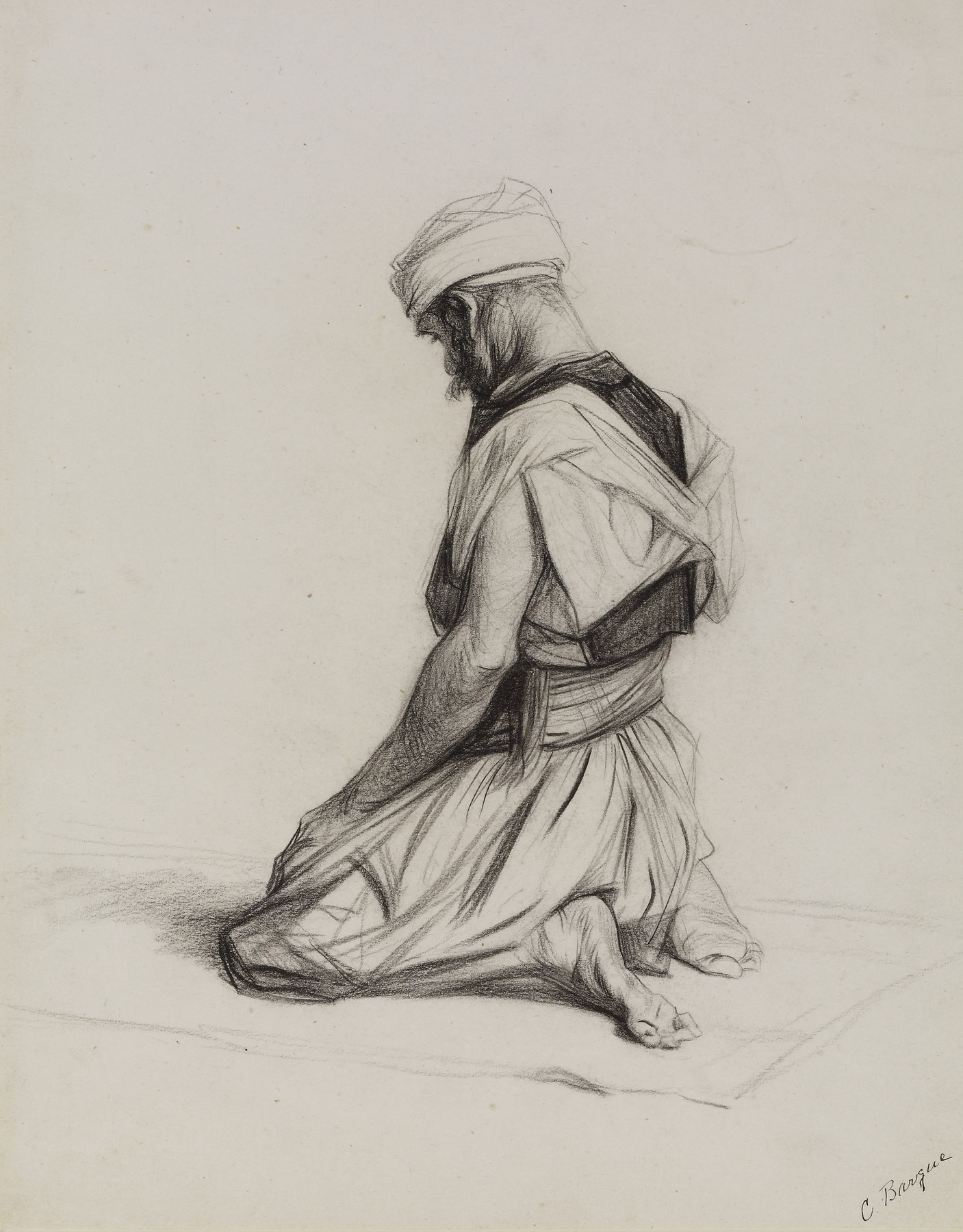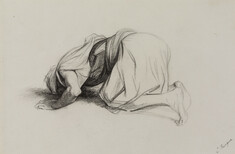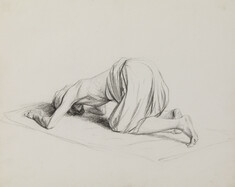Arab Kneeling in Prayer
(18th and 19th Centuries )
Charles Bargue produced relatively few paintings and is best known for his prints and drawing manuals. In his early career, he produced lithographs after his own comedic genre paintings as well as the nudes and genre scenes of others. Bargue never showed his paintings at the Salon but did exhibit a series of reproductive lithographs at the Salons of 1867 and 1868. He died insane in a mental asylum in April 1883. He was largely forgotten for a long time, but in recent years, has begun to attract increasing market and scholarly interest. Bargue has often been cited as a pupil of Gérôme, but contemporary texts stress that he was an assistant and collaborator. The two men worked together on the first two volumes of a major drawing manual, "Cours de Dessin," which was published in three parts between 1868 and 1872.
"Arab Kneeling in Prayer," is a charcoal study for a figure in the grisaille painting "Arabs at Prayer," a work that, unusually for Bargue, was a multifigure scene. The drawing has a shiny quality due to the application of a fixative that has created a yellow halo around the figure. Bargue demonstrates the newly spontaneous and sophisticated style that he began to develop around 1870, and which is also evident in the third part of the drawing manual "Cours de Dessin," published under his name alone. The feet of the kneeling man, for example, are rendered in rapidly marked angular and broken lines in a kind of visual shorthand. The drawing can thus be dated to the final years of Bargue's life, perhaps to around 1875. There are a number of related preparatory drawings. These include three charcoal figure studies also in the Walters Art Museum (37.1222, 37.1328, and 37.1339). One of these is a variant of the same kneeling figure, while the other two show prostrate figures at prayer. There is also a rapidly worked compositional oil sketch, recently on the art market (Sotheby's New York, 23 October 1997). These preparatory studies all document the thought and detailed process behind Bargue's finished works. It is probable that these studies and the grisaille were all leading towards a final colored composition that, as yet, remains unlocated.
Inscription
Provenance
Provenance (from the French provenir, 'to come from/forth') is the chronology of the ownership, custody, or location of a historical object. Learn more about provenance at the Walters.
Goupil, Paris; purchased by William T. Walters (through George A. Lucas as agent), Baltimore, 1883; inherited by Henry Walters, Baltimore, 1894; by bequest to Walters Art Museum, 1931.
Exhibitions
| 2015-2016 | Gérôme and His Circle: Travel, Art, and Business in the Middle East. The Walters Art Museum, Baltimore. |
| 2005-2006 | The Essence of Line: French Drawings from Ingres to Degas. The Walters Art Museum, Baltimore; Baltimore Museum of Art, Baltimore; Birmingham Museum of Art, Birmingham; Tacoma Art Museum, Tacoma. |
| 1992-1993 | Italian Vistas: Selections from the Permanent Collection. The Walters Art Gallery, Baltimore. |
| 1992 | French Masterworks on Paper. The Walters Art Gallery, Baltimore. |
| 1983 | A Connoisseur's Portfolio: Nineteenth-century Drawings and Watercolors in the Walters Art Gallery. The Walters Art Gallery, Baltimore. |
Conservation
| Date | Description | Narrative |
|---|---|---|
| 1/1/2002 | Treatment | examined for exhibition; cleaned; mounted; other |
Geographies
France (Place of Origin)
Measurements
H: 9 7/16 x W: 7 3/8 in. (23.9 x 18.8 cm); Mat H: 19 1/4 × 14 1/4 in. (48.9 × 36.2 cm)
Credit Line
Acquired by William T. Walters, 1883
Location in Museum
Not on view
Accession Number
In libraries, galleries, museums, and archives, an accession number is a unique identifier assigned to each object in the collection.
In libraries, galleries, museums, and archives, an accession number is a unique identifier assigned to each object in the collection.
37.1338







